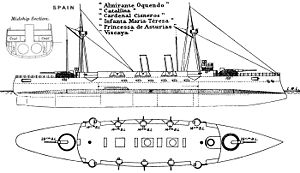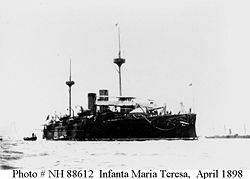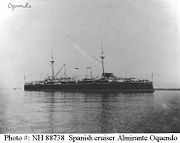
Infanta Maria Teresa class armored cruiser
Encyclopedia
The Infanta Maria Teresa class of three armored cruisers were built for the Spanish Navy
Spanish Navy
The Spanish Navy is the maritime branch of the Spanish Armed Forces, one of the oldest active naval forces in the world. The Armada is responsible for notable achievements in world history such as the discovery of Americas, the first world circumnavigation, and the discovery of a maritime path...
between 1889 and 1893. All three were sunk in action against the United States Navy
United States Navy
The United States Navy is the naval warfare service branch of the United States Armed Forces and one of the seven uniformed services of the United States. The U.S. Navy is the largest in the world; its battle fleet tonnage is greater than that of the next 13 largest navies combined. The U.S...
during the Battle of Santiago de Cuba
Battle of Santiago de Cuba
The Battle of Santiago de Cuba, fought between Spain and the United States on 3 July 1898, was the largest naval engagement of the Spanish-American War and resulted in the destruction of the Spanish Navy's Caribbean Squadron.-Spanish Fleet:...
in 1898.
Description

Bilbao
Bilbao ) is a Spanish municipality, capital of the province of Biscay, in the autonomous community of the Basque Country. With a population of 353,187 , it is the largest city of its autonomous community and the tenth largest in Spain...
, Spain
Spain
Spain , officially the Kingdom of Spain languages]] under the European Charter for Regional or Minority Languages. In each of these, Spain's official name is as follows:;;;;;;), is a country and member state of the European Union located in southwestern Europe on the Iberian Peninsula...
, built all three units of the Infanta Maria Teresa class. Originally, the Spanish Navy had planned to build sister ships of the battleship
Battleship
A battleship is a large armored warship with a main battery consisting of heavy caliber guns. Battleships were larger, better armed and armored than cruisers and destroyers. As the largest armed ships in a fleet, battleships were used to attain command of the sea and represented the apex of a...
Pelayo
Spanish battleship Pelayo
Pelayo was a battleship of the Spanish Navy which served in the Spanish fleet from 1888 to 1925. For many years, she was the most powerful unit of the Spanish Navy.-Technical Characteristics:...
, but a crisis with the German Empire
German Empire
The German Empire refers to Germany during the "Second Reich" period from the unification of Germany and proclamation of Wilhelm I as German Emperor on 18 January 1871, to 1918, when it became a federal republic after defeat in World War I and the abdication of the Emperor, Wilhelm II.The German...
in the Caroline Islands
Caroline Islands
The Caroline Islands are a widely scattered archipelago of tiny islands in the western Pacific Ocean, to the north of New Guinea. Politically they are divided between the Federated States of Micronesia in the eastern part of the group, and Palau at the extreme western end...
in 1890 caused Spain to divert money budgeted for the battleships to the Infanta Maria Teresa class instead. The armored cruisers were considered more desirable than additional battleships at the time because their greater speed and steaming range made them better suited for responses to colonial crises.
The two-funnelled Infanta Maria Teresa class was fast and well-armed, with 11-inch ( Hontoria 280-mm) guns mounted in barbettes on the center line fore and aft and a large secondary battery of 5.5-inch (140-mm) guns. But their protection was poor: The armor belt was narrow and stretched for only two-thirds of the length of the hulls, the main guns had only lightly armored hoods, the 5.5-inch (140-mm) guns were mounted in the open on the upper deck, and the ships had a high, unprotected freeboard. Their upper decks were planked-over beams without steel plating. The ships also were heavily decorated and furnished with wood, which the Spanish failed to remove before combat and which would feed fires after enemy shell hits.
History
The Infanta Maria Teresa-class armored cruisers were active units, serving both in European and American waters. After the outbreak of the Spanish-American WarSpanish-American War
The Spanish–American War was a conflict in 1898 between Spain and the United States, effectively the result of American intervention in the ongoing Cuban War of Independence...
, all three were assigned to the 1st Squadron, commanded by Vice Admiral Pascual Cervera y Topete
Pascual Cervera y Topete
Pascual Cervera y Topete served as an admiral of the Spanish Caribbean Squadron during the Spanish-American War, and prior to this served his country in a variety of military and political roles....
, in which all three were sunk at the Battle of Santiago de Cuba
Battle of Santiago de Cuba
The Battle of Santiago de Cuba, fought between Spain and the United States on 3 July 1898, was the largest naval engagement of the Spanish-American War and resulted in the destruction of the Spanish Navy's Caribbean Squadron.-Spanish Fleet:...
.
Infanta Maria Teresa

Spanish cruiser Infanta Maria Teresa
Infanta Maria Teresa was an Infanta Maria Teresa-class armored cruiser of the Spanish Navy that fought at the Battle of Santiago de Cuba during the Spanish-American War.-Technical characteristics:...
was named for a Spanish princess. In Spain
Spain
Spain , officially the Kingdom of Spain languages]] under the European Charter for Regional or Minority Languages. In each of these, Spain's official name is as follows:;;;;;;), is a country and member state of the European Union located in southwestern Europe on the Iberian Peninsula...
at the outbreak of the Spanish-American War
Spanish-American War
The Spanish–American War was a conflict in 1898 between Spain and the United States, effectively the result of American intervention in the ongoing Cuban War of Independence...
in April 1898, she was sent along with her sisters to the Caribbean
Caribbean
The Caribbean is a crescent-shaped group of islands more than 2,000 miles long separating the Gulf of Mexico and the Caribbean Sea, to the west and south, from the Atlantic Ocean, to the east and north...
as part of Cervera's squadron, blockaded for 37 days in the harbor of Santiago de Cuba
Santiago de Cuba
Santiago de Cuba is the second largest city of Cuba and capital city of Santiago de Cuba Province in the south-eastern area of the island, some south-east of the Cuban capital of Havana....
, and sunk in the Battle of Santiago de Cuba
Battle of Santiago de Cuba
The Battle of Santiago de Cuba, fought between Spain and the United States on 3 July 1898, was the largest naval engagement of the Spanish-American War and resulted in the destruction of the Spanish Navy's Caribbean Squadron.-Spanish Fleet:...
on 3 July 1898.
Vizcaya
Ordered in 1889, launched on 8 July 1891, and completed in 1893, VizcayaSpanish cruiser Vizcaya
Vizcaya, was an Infanta Maria Teresa-class armored cruiser of the Spanish Navy that fought at the Battle of Santiago de Cuba during the Spanish-American War.-Technical characteristics:...
was named for a Spanish province. She was visiting New York City
New York City
New York is the most populous city in the United States and the center of the New York Metropolitan Area, one of the most populous metropolitan areas in the world. New York exerts a significant impact upon global commerce, finance, media, art, fashion, research, technology, education, and...
at the time of the destruction of battleship USS Maine
USS Maine (ACR-1)
USS Maine was the United States Navy's second commissioned pre-dreadnought battleship, although she was originally classified as an armored cruiser. She is best known for her catastrophic loss in Havana harbor. Maine had been sent to Havana, Cuba to protect U.S. interests during the Cuban revolt...
in February 1898. Ordered across the Atlantic to join Cervera in the Cape Verde Islands, she was sent along with her sisters to the Caribbean
Caribbean
The Caribbean is a crescent-shaped group of islands more than 2,000 miles long separating the Gulf of Mexico and the Caribbean Sea, to the west and south, from the Atlantic Ocean, to the east and north...
as part of Cervera's squadron, blockaded for 37 days in the harbor of Santiago de Cuba
Santiago de Cuba
Santiago de Cuba is the second largest city of Cuba and capital city of Santiago de Cuba Province in the south-eastern area of the island, some south-east of the Cuban capital of Havana....
, and sunk in the Battle of Santiago de Cuba
Battle of Santiago de Cuba
The Battle of Santiago de Cuba, fought between Spain and the United States on 3 July 1898, was the largest naval engagement of the Spanish-American War and resulted in the destruction of the Spanish Navy's Caribbean Squadron.-Spanish Fleet:...
on 3 July 1898.
Almirante Oquendo

Spanish cruiser Almirante Oquendo
Almirante Oquendo, was an Infanta Maria Teresa-class armored cruiser of the Spanish Navy that fought at the Battle of Santiago de Cuba during the Spanish-American War.-Technical characteristics:...
was in Havana
Havana
Havana is the capital city, province, major port, and leading commercial centre of Cuba. The city proper has a population of 2.1 million inhabitants, and it spans a total of — making it the largest city in the Caribbean region, and the most populous...
, Cuba
Cuba
The Republic of Cuba is an island nation in the Caribbean. The nation of Cuba consists of the main island of Cuba, the Isla de la Juventud, and several archipelagos. Havana is the largest city in Cuba and the country's capital. Santiago de Cuba is the second largest city...
, when war with the United States
United States
The United States of America is a federal constitutional republic comprising fifty states and a federal district...
became likely in the spring of 1898. Ordered across the Atlantic to join Cervera in the Cape Verde Islands, she was sent along with her sisters to the Caribbean
Caribbean
The Caribbean is a crescent-shaped group of islands more than 2,000 miles long separating the Gulf of Mexico and the Caribbean Sea, to the west and south, from the Atlantic Ocean, to the east and north...
as part of Cervera's squadron, blockaded for 37 days in the harbor of Santiago de Cuba
Santiago de Cuba
Santiago de Cuba is the second largest city of Cuba and capital city of Santiago de Cuba Province in the south-eastern area of the island, some south-east of the Cuban capital of Havana....
, and sunk in the Battle of Santiago de Cuba
Battle of Santiago de Cuba
The Battle of Santiago de Cuba, fought between Spain and the United States on 3 July 1898, was the largest naval engagement of the Spanish-American War and resulted in the destruction of the Spanish Navy's Caribbean Squadron.-Spanish Fleet:...
on 3 July 1898.
External links
- The Spanish-American War Centennial Web Site: Spanish Navy
- Department of the Navy: Naval Historical Center: Online Library of Selected Images: Spanish Navy Ships: Vizcaya (Armored Cruiser, 1891-1898)
- Department of the Navy: Naval Historical Center: Online Library of Selected Images: Spanish Navy Ships: Almirante Oquendo (Armored Cruiser, 1891-1898)
- Department of the Navy: Naval Historical Center: Online Library of Selected Images: Spanish Navy Ships: Infanta Maria Teresa (Armored Cruiser, 1890-1898)

